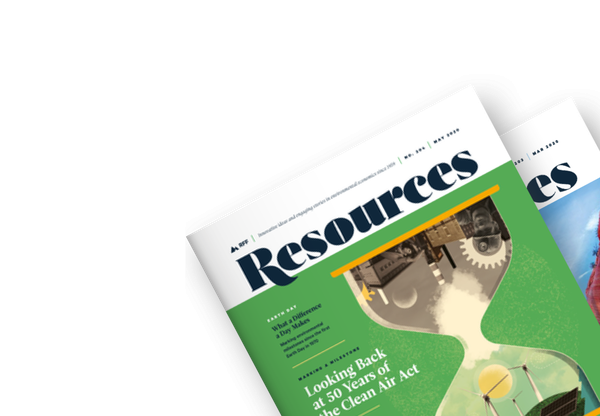Twice a month, we’re compiling the most relevant news stories from diverse sources online, connecting the latest environmental and energy economics research to global current events, real-time public discourse, and policy decisions. Keep reading, and feel free to send us your feedback. One brief editor’s note: This newsletter will be the last coauthored by Matt Fleck, who will be starting a new role elsewhere in July and is grateful for the opportunity to have contributed to the newsletter over the past three years.
Here are some questions we’re asking and addressing with our research chops this week:

Can states support the adoption of electric vehicles in the potential absence of federal support?
The budget reconciliation package that currently is being advanced by congressional Republicans now includes a plan to repeal consumer tax credits for electric vehicle (EV) purchases at the end of 2025. These credits offer consumers a tax credit worth up to $7,500 on a purchase of a qualifying vehicle. Changes to the budget reconciliation package may get incorporated as the bill moves through Congress, but the EV subsidies seem to have long odds. With federal support waning, states may expand their own incentives for EV adoption. Resources for the Future (RFF) researchers Beia Spiller, Joshua Linn, and Nafisa Lohawala explore how states can advance EV adoption in an article from the latest issue of Resources magazine. “To meet ambitious goals that address climate change and EVs in the absence of federal support, state governments will have to revisit both the scope of their policies and the magnitude of their investments for transitioning to EVs,” say the researchers. Check out the online edition of Resources for more articles on the transportation sector and its evolving policy landscape.
As the administration rolls back regulations to cut costs, how can policymakers try to ensure that those decisions reflect not just cost savings, but overall net benefits for Americans?
The US Environmental Protection Agency has announced plans to weaken national limits on perfluoroalkyl and polyfluoroalkyl substances (PFAS) in drinking water. Exposure to these “forever chemicals” (known as such because the chemical bonds do not break down easily, so the substances remain in the environment for long periods) is linked to serious health risks. While limits on some PFAS will remain, the agency plans to extend deadlines for utilities to meet these limits, citing compliance challenges. The move is part of a broader federal rollback of environmental regulations. RFF Senior Fellow Alan Krupnick outlines how the effects of such regulatory repeals can be evaluated to more accurately weigh their costs and benefits in a new installment of the If/Then policy analysis series. “Amending or repealing regulations that do not provide a net benefit to the American people is a laudable goal,” Krupnick says, “but informing the decisionmaking process will require careful analysis that uses transparent methodology.” These methods differ somewhat from other methods that evaluate the costs and benefits of a new rule, Krupnick adds.
How can smart policies help households in the United States become less vulnerable to extreme weather events, while ensuring that housing remains affordable?
Atlantic hurricane season officially begins on June 1. The approaching season has residents and officials alike anxious about the severity of this year’s storms. The risk of hurricane damage is becoming more pressing as population growth accelerates in vulnerable areas and climate change exacerbates extreme weather events. An analysis of US Census data shows that states with some of the highest exposure to extreme weather events, such as hurricanes and wildfires, also are seeing the biggest influx of new residents; namely, Texas, Florida, North Carolina, South Carolina, Georgia, and Arizona. On this week’s episode of Resources Radio, Jenny Schuetz, vice president of infrastructure and housing at Arnold Ventures, emphasizes the need for better information about both regional and hyperlocal climate risks, along with policy changes that expand access to affordable housing in safe areas. “We need to be building more homes in climate-resilient areas in order to not push into some of the more vulnerable places,” Schuetz says.

Expert Perspectives
In Focus: Tariffs and the US Auto Market
Earlier this spring, the Trump administration imposed tariffs on imported vehicles and most vehicle parts. The tariffs are game-changing for US auto manufacturers, which compete with foreign companies and use imported parts in their own assembly lines. What could the tariffs mean for these companies and US consumers? In this In Focus video, University of Maryland Professor and RFF Senior Fellow Joshua Linn discusses new RFF modeling that projects the effects of auto tariffs on consumer costs, vehicle demand, electric vehicles, and more.
Environmental Policy Changes in the Congressional Budget Reconciliation Package
With fits and starts, the Republicans’ budget reconciliation bill—a mechanism which enables certain legislation to evade the Senate filibuster—has passed the House of Representatives, but policy issues remain unresolved as the bill now moves to be considered by the upper chamber. Among those issues is the fate of the array of clean energy and investment tax credits introduced by the Inflation Reduction Act (IRA) in 2022.
“An underrated aspect of the IRA is the degree to which it has spread the wealth, so to speak, of clean energy investments,” says Liam Burke, RFF’s government affairs manager. “Red states have benefited enormously from IRA tax credits, which has created a real constituency that is starting to make noise about preserving the credits to at least some degree. This House-passed bill rapidly phases out most of the IRA incentives. The primary tension as this bill moves forward will be between the representatives and senators who want to cut spending at all costs and those who want to keep the clean energy tax credit superstructure intact in the IRA.”

Resources Roundup

Talking About the Affordability of Electricity in the United States
Despite the falling costs of solar energy and a plentiful supply of natural gas in the United States, maintenance of infrastructure on the electric grid and increasingly frequent and intense extreme weather events have pushed up electricity prices for consumers. Tariffs, trade wars, and the potential repeal of clean energy tax credits could further increase prices. Join RFF and Canary Media on Tuesday, June 3, for a discussion of solutions that could help bring down the price of electricity, including a build-out of inexpensive clean energy and modernizing how utilities charge customers. Request a spot at the event.
The Cost of Delaying Upgrades to the Electric Grid and Additions of New Electricity Generation
As electricity demand increases, the United States is in a race to add more power lines and electricity generation to the country’s aging electric grid. However, these upgrades are taking much longer than they used to. In a pair of new reports, RFF researchers estimate that preventing delays to these upgrades could save consumers tens of billions of dollars per year, increase the reliability of the electric grid, and prevent premature deaths by reducing air pollution. The benefits of preventing these delays would be especially large for low-income, Black, and Hispanic households. “Despite widespread political support, numerous obstacles are stalling urgently needed upgrades to the US electric grid,” says RFF Senior Research Associate McKenna Peplinski, a coauthor of both reports, in the press release for the reports. “Slow permitting processes, unstable investment conditions, local pushback, and other factors have contributed to long development timelines that complicate the challenge of meeting demand growth.”
Examining Oklahoma’s Approach to Economic Resilience
The state economy of Oklahoma is heavily dependent on the oil and gas industry. Yet, as the global energy system shifts away from oil and gas, Oklahoma has made few efforts to diversify its economy and build economic resilience. In a new report, RFF researchers and coauthors at partner institutions examine the strategies employed by the state of Oklahoma and its capital, Oklahoma City, to build economic resilience, along with the views of local stakeholders on these strategies, obstacles to economic development, and potential improvements to existing policies. The report is part of the Resilient Energy Economies initiative and the third in a series about the opportunities and challenges in US oil- and gas-producing communities.
Projecting the Effects of the Foreign Pollution Fee Act of 2025
Carbon border adjustments are tariffs that charge importers based on the carbon dioxide emissions that are associated with the imported goods. This kind of tariff has emerged as a key policy in discussions about international trade and emissions reductions, and some governments already have put a version of the policy in place. In the United States, Senators Bill Cassidy (R-LA) and Lindsey Graham (R-SC) recently introduced the Foreign Pollution Fee Act of 2025, which would impose tariffs on an array of goods based on the emissions associated with the production of those goods in the country from which they were imported, relative to the emissions associated with production of the same goods in the United States. In a new issue brief, RFF researchers assess the potential effects of the bill on US manufacturing, global emissions, and more. “US emissions increase due to greater domestic manufacturing,” say the authors. “The net effect is that global emissions are relatively unchanged by the policy.”

#ChartoftheWeek

Image courtesy of Penguin Random House
The inaugural Climate Fiction Prize was awarded last week to Nigerian author Abi Daré for her novel And So I Roar. The novel follows a 14-year-old girl, Adunni, who returns from Lagos to her home village to face spurious charges for events that are due to climate change. Novels are important in addressing climate change, says Daré, because they “take big, overwhelming issues and place them in the hands of people we come to know and care about.” The founders of the prize aim to “reward and showcase powerful stories that depict the human response to climate change.”








